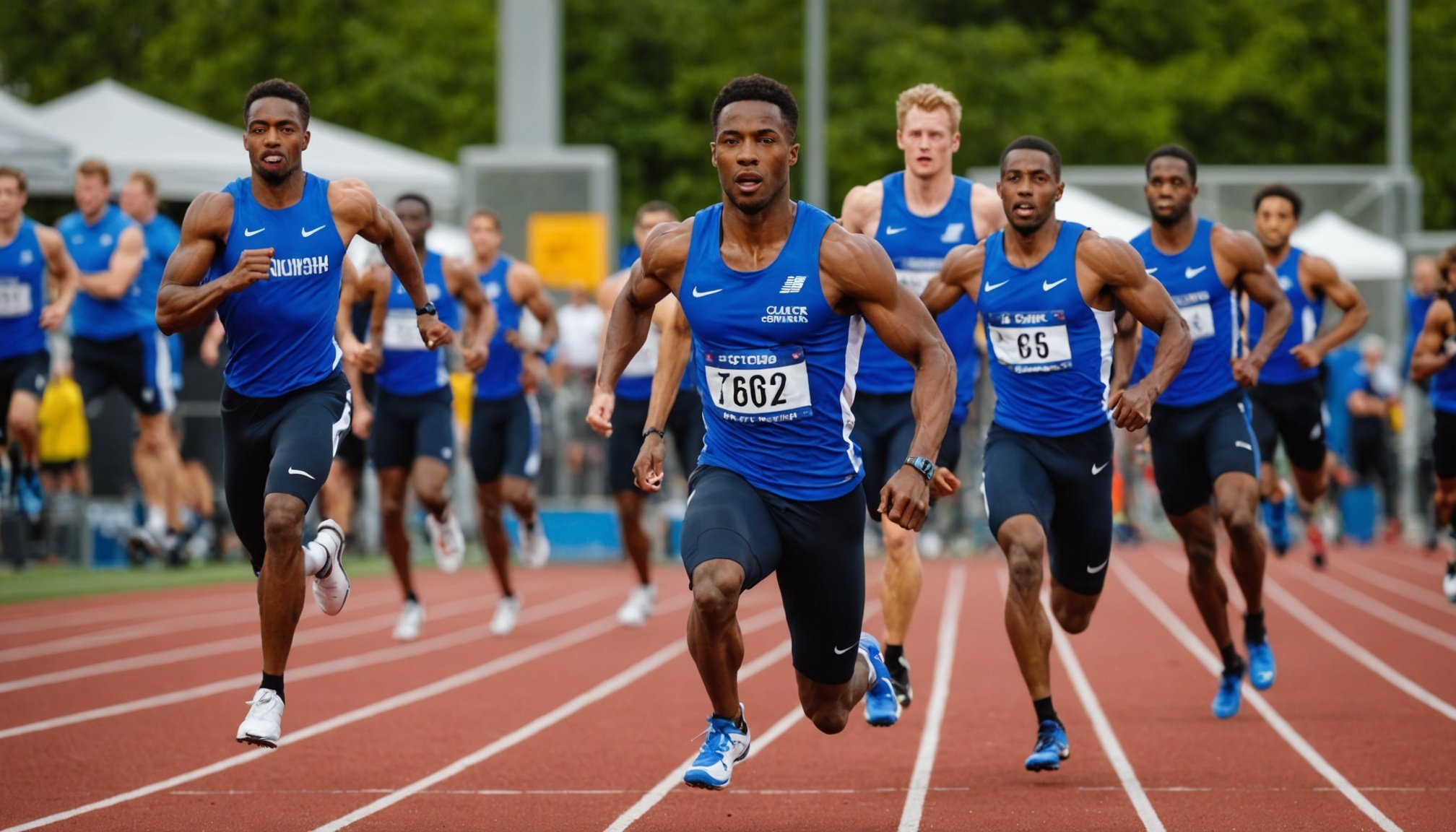Unleashing Speed: Top Warm-Up Routines for UK Sprinters to Maximize Performance
When it comes to sprinting, the difference between a good performance and an exceptional one often lies in the preparation. A well-structured warm-up routine is crucial for sprinters to maximize their speed, power, and overall performance. Here’s a comprehensive guide on how UK sprinters can unleash their full potential through effective warm-up routines.
The Importance of a Warm-Up Routine
A warm-up routine is more than just a preparatory phase; it sets the tone for the entire competition. By elevating your body temperature and increasing blood flow to your muscles, you are not only preventing injuries but also preparing your body to perform at its best.
Also read : Effective Tactics for UK Sports Clubs to Combat Online Bullying and Harassment
“As a sprinter, you need to understand that a warm-up is not just about getting your heart rate up, but also about preparing your muscles and joints for the explosive movements required in a sprint,” says Colin Harris, a professional athlete trainer and founder of Sprintingspeed.
Dynamic Stretching: Essential for Muscle Activation
Dynamic stretching is a critical component of any sprinter’s warm-up routine. Unlike static stretching, which involves holding a single position for an extended period, dynamic stretching incorporates active movements that mimic the actual actions performed during sprinting.
Also to read : Exploring Altitude”s Impact on Aerobic Performance: Essential Adaptation Strategies for UK Mountain Bikers
Key Dynamic Stretching Exercises
- Leg Swings: Stand with your feet hip-width apart and swing one leg forward and backward, then switch to the other leg. This helps in loosening the hip and leg muscles.
- High Knees: Run in place, bringing one knee up towards your chest while keeping the other foot on the ground. This exercise activates the major muscle groups involved in sprinting.
- Butt Kicks: Run in place, kicking your heels back towards your glutes. This helps in warming up the hamstrings and glutes.
- Lunges: Perform walking lunges to stretch and warm up the lower body muscles.
These dynamic stretches increase muscle temperature and flexibility, while also improving joint range of motion. Here’s what Jonas Dodoo, a speed coach and founder of Speedworks, has to say about dynamic stretching:
“Dynamic stretching prepares the muscles and joints for the explosive movements required in a race. It’s essential to include movements like leg swings, high knees, and butt kicks in your warm-up routine to ensure you’re fully primed for the competition”.
Specific Drills: Mimicking Competition Movements
After dynamic stretching, incorporating specific drills into your warm-up routine is essential. These drills should replicate the exact movements you will perform during the race, ensuring that your body is fully prepared for the specific demands of sprinting.
Key Sprint Drills
- A-Skips: Focus on proper knee lift and foot strike. This drill emphasizes the explosive power needed for sprinting.
- B-Skips: Similar to A-skips but with an added emphasis on hip drive and arm swing.
- Karaoke: A lateral movement drill that focuses on agility and change of direction. It helps in improving your ability to quickly change direction, which is crucial in many sprint events.
These drills focus on aspects such as knee lift, arm drive, and foot placement, all of which are crucial for maximizing speed and efficiency on the track.
High-Intensity Phase: Simulating Race Conditions
The final phase of your warm-up routine should include high-intensity activities that simulate race conditions. This phase is crucial for ensuring that your body is ready to perform at maximum speed and intensity.
High-Intensity Activities
- Short Sprints: Start with short sprints of 20-50 meters to get your body accustomed to the high-intensity demands of sprinting.
- Strides: Perform longer strides at a slightly lower intensity than full sprints. This helps in building speed endurance.
- Tempo Runs: Incorporate tempo runs to simulate the pace and intensity of the actual race.
These activities should be performed with proper technique and focus on aspects such as start mechanics, stride length, and arm drive. Here’s an example of how to structure this phase:
| Activity | Duration | Intensity | Focus |
|---|---|---|---|
| Short Sprints | 20-50 meters | Maximum | Start mechanics, explosive power |
| Strides | 50-100 meters | High | Speed endurance, stride length |
| Tempo Runs | 100-200 meters | High | Pace, arm drive, foot placement |
By including a high-intensity phase in your warm-up routine, you not only enhance your muscle activation and readiness but also build confidence in your ability to perform at your best.
Mental Preparation: The Final Piece of the Puzzle
Mental preparation is key to ensuring that you are fully prepared for the competition, both physically and mentally. Here are some techniques to incorporate into your warm-up routine:
Breathing Exercises
Deep, controlled breathing can help calm your nerves and ensure that you remain focused and composed. Take a few minutes to practice deep breathing exercises before your sprint.
Positive Affirmations
Positive affirmations such as “I am strong,” “I am fast,” and “I am ready” can boost your confidence and ensure that you are mentally prepared for the race.
Sample Warm-Up Routine
Here’s a sample warm-up routine that you can follow:
General Warm-Up (10-15 minutes)
- Light jogging to get the body moving
- Dynamic stretching (leg swings, high knees, butt kicks)
Specific Drills (10-15 minutes)
- A-skips
- B-skips
- Karaoke
High-Intensity Phase (10-15 minutes)
- Short sprints
- Strides
- Tempo runs
Mental Preparation (5 minutes)
- Breathing exercises
- Positive affirmations
Strength Training to Complement Your Sprint Training
While the warm-up routine is crucial, it’s also important to incorporate strength training into your overall training program. Strength training helps in building the power and strength needed for sprinting.
Key Strength Training Exercises
- Squats: Essential for building powerful glutes and lower body strength.
- Jump Squats: Helps in building explosive power and muscle efficiency.
- Burpees: Increases the explosive power of the quads, glutes, hamstrings, and calf muscles, while also building upper body and core strength.
- Glute Bridges: Great for activating the glutes and core muscles.
Here’s what Lucy Hurn, a triathlon coach, says about strength training for runners:
“Strength training is not just about lifting heavy weights; it’s about building the stability and power needed to perform at your best. It’s essential to break down your workouts into mobility work, stability, strength, and power to ensure you’re covering all aspects of your training”.
Practical Tips and Advice
- Make Sure to Rest: Ensure you get adequate rest between your warm-up sessions and your actual sprint training. This helps in preventing injuries and allowing your muscles to recover.
- Workout Consistently: Consistency is key when it comes to training. Make sure to include your warm-up routine and strength training in your regular workout schedule.
- Focus on Proper Form: Proper form is crucial when performing any exercise. Ensure you’re doing each exercise correctly to get the most benefit and reduce the risk of injury.
- Change Direction: Incorporate agility training into your routine, such as karaoke drills, to improve your ability to quickly change direction.
By following these tips and incorporating a well-structured warm-up routine into your training program, you can significantly improve your speed, power, and overall performance as a sprinter.
In conclusion, a comprehensive warm-up routine that includes dynamic stretching, specific drills, high-intensity activities, and mental preparation is essential for UK sprinters looking to maximize their performance. By combining this with a solid strength training program, you can ensure that you’re fully prepared to unleash your speed and power on the track.











